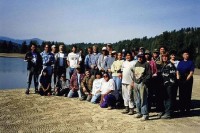Blog Categories
- Blog home
- Cariboo Chilcotin Coast (9)
- Mighty Fraser Country (19)
- Northern BC (10)
- The Kootenays (17)
- Thompson-Okanagan (19)
- Tourism Associations (3)
- Uncategorized (0)
- Vancouver (197)
- Vancouver Coast Mountains (26)
- Vancouver Island (110)
- Victoria (57)
- Whistler (17)
Related Travel Information
10th Anniversary of St. Eugene Golf Resort Casino
- Author: WendyVP
- Accommodation: The Kootenays
April 6, 2010 – Cranbrook, British Columbia
The year 2010 marks the 10th anniversary of the opening of the golf course at the St. Eugene Golf Resort Casino. What many people are not aware of is the work and dedication to an ideal that transpired years before the first golfer took the first swing at the course.
“The first year I was here was in 1995,” said Graeme Douglas, CGSA, manager, golf and hotel facilities. “I had been working on courses in Europe and Les Furber wanted me to come see the project. The Mission building was a shell, but the land was spectacular. It had a very special feeling to it.”
After initial work, Douglas was called to Cuba, where he and his team completed the now-famous Varadero golf course. Shortly afterwards, in 1998, he came back to the St. Eugene and began work in earnest.
“Myself, Les (Furber), and GDS (Golf Design Services) made a commitment and pulled in a lot of expertise. We pushed hard to get the project shaped and seeded. We soon found that the first nation’s component would help us a lot. The Ktunaxa were comfortable in shaping the grounds and the work that needed to be done. We had 80 per cent first nation’s people working on the course.”
Despite the work, the project stalled. It is important to remember that the Ktunaxa Kinbasket Tribal Council, under the leadership of former St. Mary’s Indian Band Chief Sophie Pierre, was going into an undertaking unheard of in Western Canada. They had to raise $40 million for their dream of a world class resort, casino and premiere golf course. Another hurdle was that many members of the band at the time, wanted to see the old mission building destroyed.
“We could not afford to just let it drop,” said Pierre, chief commissioner for the BC Treaty Commission. “There was so much invested. I felt responsible not just for aboriginal economic development, but for the social justice side too because this was on the site of a former residential school. It was also a huge project for the region.”
Helder Ponte, director, economic investment for the Ktunaxa Nation Council and key figure in the development of the golf course, casino and resort, explained that resources had to be found.
“With respect to the golf course, the Columbia Basin Trust helped immensely. It would not have been possible without them. They agreed to build the course ahead of the rest of the resort. It opened in May 20, 2000. Because we had the golf course, it helped us get what we needed for the other two components.” said Ponte.
Kathryn Teneese, Ktunaxa Nation chair, agreed with Ponte about the economic and social aspects of the course. “This is a real recognition of doing business on Ktunaxa territory,” said Teneese. “But more than that, it shows we can do business while maintaining the land and giving something back to our people.” She added that the annual June charity golf tournament that has become a mainstay event of the area and is a clear example of the business working for the community.
The work was completed and the development team soon realized that their best tool in attaining investment was just to drive potential investors and season pass holders to the 13th hole and have them survey the grounds. Season packages soon became the hottest tickets for golfers and the course took third place in Golf Digest’s Best New Canadian Golf Course in 2001.
And the group managed not only to create a unique golf destination, they did so without sacrificing the values of the land or the people who have called it home for 10,000 years. Today the course features holes named in Ktunaxa, (with phonetic pronunciations) and entrance to some hazards are prohibited to protect fragile environments. (Errant golf balls are recovered by the grounds crew and given away freely to help prevent damage to the area). It is also the cornerstone that helped raised investment for the 4


